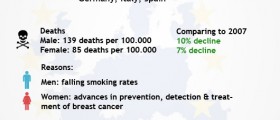
The term maternal health stands for the health of women during their pregnancy, the process of childbirth and the period once the child is born. All these stages require health control, careful lifestyle planning and various forms of caution and care, ensuring the well-being of both mothers and their children.
Basically, women need to obtain the necessary education, health information and medical support before they enter the stage of pregnancy, knowing what to expect and how to go through this period the safest way possible. Later, once the child is born, mothers need to know how to take good care of him/her in terms of nutrition, family planning and other such factors, not neglecting their own health during the process. All these things are a part of something we call maternal health.
Low Maternal Health is a Global Issue
Currently, in most developing countries, the main reason behind deaths of women in their reproductive age, lies in low maternal health, especially through pregnancy and childbirth complications which are not properly and timely treated.
In fact, the WHO in a report from 2005 claimed that poor maternal health is the 4th global cause of death in women. While pregnancy and childbirth complications cause 34% of maternal deaths in developing countries, the numbers are much lower in developed countries, being about 13%.
Around the world, in the most developed of all countries, incidents like maternal death rarely take place, due to the high quality medical equipment and maximum health care. Yet, for the rest of the world, maternal death seems to be a common issue, with about 342,000 women dying during their pregnancy or childbirth in 2008.
Strangely enough, these numbers are a significant improvement in comparison to, for example, the 1980s, where 526,300 women died for the above mentioned reasons.
Several reasons are behind these catastrophic facts. First of all, low income on a level of a whole country makes it impossible for women to receive proper medical care during their pregnancies and childbirth. Secondly, lack of professional medical staff in many developing countries only adds to the risk of maternal death. Additionally, diseases like HIV/AIDS lead to about 45% of infected mothers carrying the virus to the children. Moreover, this disease took about 60,000 maternal lives in 2008, mostly in Africa, where maternal death is a serious and ever-growing problem.
However, death is not the only issue under the term of lack of maternal health. Namely, for every woman who dies during childbirth or pregnancy, about 20 others end up with diseases, infections, injuries or disabilities even though they do not lose their lives.
Finally, keep in mind that about 50% of all pregnancies all over the developing world happen in conditions which are far from medically required ones in terms of professional approaches, hygiene and other such factors. Naturally, this affects maternal health as well, decreasing it significantly.
Ways to Improve Maternal Health and Millennium Goals
In order to find solutions for this problem, the World Bank gave information that not more than $3 are necessary to be spent on every person in order to provide for a successful family planning program and all the requirements of maternal health in countries where these factors are not present. Guided by this information, many non-governmental and non-profit organizations are doing their best to educate people and change the current grim state of affairs regarding the issue of global maternal health.
The United Nations Population Fund started a campaign for reducing maternal deaths in Africa, mainly focusing on providing proper health facilities and health care for mothers and pregnant women. Through this process, people are trying to change the negative status quo in countries where maternal health is at the lowest possible level.
Speaking of the United Nations, this organizations has developed a Millennium Plan, desiring to reduce the number of maternal deaths to only a single quarter of the current state by the year 2015. The organization plans to achieve this through educating and providing more qualified birth attendants in this country and spreading awareness of the importance of proper contraception and a well-developed system of family planning.
This plan has already resulted in a 50% reduction in maternal deaths or maternal health complications. However, there is still plenty of room for further improvement.
So far, the results have been more than positive, according to many researches carried out on the subject. Basically, in Madagascar, the use of contraception has risen from 5.1% to 29% from 1992 to 2008. On the other hand, in Sweden, being the country of most global maternal deaths in the 19th century, the improvement is incredible since the introduction of proper health support. Today, this country has 300 mortality cases per 100,000 live births, which is an incredible improvement.
All in all, we still need to work on the area of maternal health. Today, regardless of the fact that women in developed countries go through their pregnancy and childbirth optimally, being introduced to the highest levels of family planning later on, in developing countries this is hardly the case. Thus, we need to help each other in order to allow this planed to grow on a global level, preventing maternal deaths whenever and wherever possible.

















Your thoughts on this
Loading...